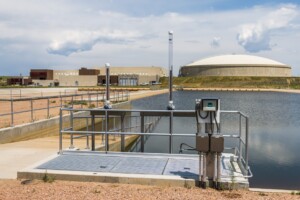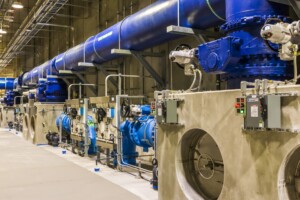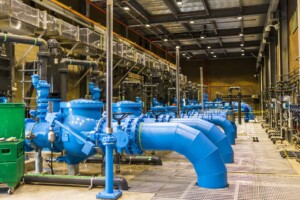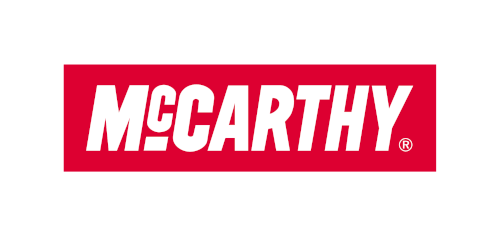Challenge
Colorado Springs Utilities (CSU) is a community-owned enterprise with a 100-year reputation of excellence. As a pioneer in providing four utility services (electric, gas, water, and wastewater) in one enterprise, CSU needed to increase its water production in order to meet future demands for safe, economical, and reliable water supply. Population growth and aging infrastructure created the need for a timely and efficient solution. The Southern Delivery System (SDS) program was created to satisfy the demand. The SDS program included bringing Arkansas River water from the Pueblo Reservoir to the cities of Colorado Springs and Fountain, as well as to the Pueblo West and Security Water districts. The project consisted of an intake at the reservoir, miles of raw water pipelines and pump stations, and a new water treatment plant (WTP) and finished water pump station (FWPS) with an initial capacity of 5 to 50 mgd expandable to 130 mgd.
The water treatment plant project site had a list of constraints that needed to be carefully considered during design. The site was filled with pockets of poor soils to depths that ranged from 20’ to 50’ below ground level; it was located adjacent to a local airport; and it would rely on surface water from a raw water source that required miles of pipeline and multiple pump stations. The location of the plant would also require distribution pipelines to connect the plant to the local distribution network. These lines would run adjacent to existing roadways, cross intersections, and cross major highways within Colorado Springs.
The US was in the middle of the worst recession in recent history when the need to procure the water treatment plant arose. This aimed the focus of the project at stimulating the local economy and ensuring the project was designed and built to be fiscally efficient, not only in capital construction cost, but over the plant’s life cycle as well.
After reviewing and updating the delivery strategy for the various components of the SDS program, CSU affirmed the use of a progressive design-build (PDB) approach for the WTP and FWPS as the best delivery method for the project. This PDB delivery approach would withstand the pressures of a tight schedule, stakeholder scrutiny, and ongoing budget concerns. It was also determined that a 100% level of design should be achieved for all the facilities before establishing a final guaranteed maximum price (GMP) for construction. Through a formal procurement process, proposing firms were required to submit their qualifications, a detailed technical approach, a fixed price for design development, and fees that would apply during the construction phase. Proposals were evaluated on a best-value basis: qualifications 15%, technical approach 40%, and cost 45%.
Approach
McCarthy Building Companies and Carollo Engineers partnered on the Edward W. Bailey Water Treatment Plant and brought forth a unique approach to the project. The original project plan called for a campus style layout. The McCarthy/ Carollo team developed a plan that would consolidate the treatment structures and limit the plant’s exposure to the poor soil conditions. The consolidated facility would include a 10-million-gallon raw water tank, flash mixing, 4-stage flocculation, lamella plate sedimentation, ozone contactors, GAC filters, sodium hypochlorite disinfection, and a 10-million-gallon finished water reservoir and finished water pump station. Solids would be handled through sedimentation drying beds onsite. The team also managed the hydraulic profile of the plant, using the natural slope of the site and burying the structures to minimize pumping and ensure the critical treatment structures were founded on good soils. Finally, the consolidated treatment structures eliminated more than four miles of yard piping, multiple pump stations, and allowed for easier operations and maintenance within a smaller facility footprint. This unique approach to the project is what led CSU to hire McCarthy/Carollo as their design-builder.
During the design phase, the McCarthy/Carollo team continued to find ways to bring benefits to the project. From the beginning, the project team held outreach events and sought out venues to discuss the project with the local subcontractor and vendor community. The goal was to ensure this project created excitement and attracted maximum participation from the local community.
CSU was heavily engaged throughout the life of the project. Value engineering was introduced early in the project during conceptual design to reinforce that ratepayers received maximum value for their dollars spent. This pushed the team to continue to look for unique proven solutions to the project challenges. The soil conditions continued to create challenges for the team. The sedimentation drying basins covered a large footprint and would require extensive ground improvement which would prove to be costly with conventional ground improvement methods. The project team ended up utilizing deep dynamic compaction (DDC) as the ground improvement solution which saved the project over $1 million.
The focus on life cycle cost played a large part in the McCarthy/Carollo team’s procurement strategy for subcontractors and vendors. As an example, the ozone system and finished water pumps were evaluated on both capital and life cycle costs, evaluating elements like power demand, maintenance, and spare parts’ costs. McCarthy/Carollo worked closely with CSU during this evaluation in an open-book environment to ensure CSU was getting the best value throughout the life cycle.
Results
The collaborative delivery approach fostered a partnering environment for the entire project team. This resulted in water being delivered on time and significantly under budget through the multi-year design and construction of the project.
During conceptual design, CSU developed an initial opinion of probable construction cost (OPCC) which was estimated at $190 million. The McCarthy/Carollo team worked closely from the beginning to save the project more than $60 million prior to the 30% cost model. The final GMP was established at $124.6 million which resulted in a 34% reduction from the initial OPCC. The project also brought opportunity for more than 50 local subcontractors and vendors and employed more than 150 men and women from the local community during the construction of the facility. The project delivered not only an efficient means for delivering safe reliable water to the local community but also acted as a stimulus to the local economy.




